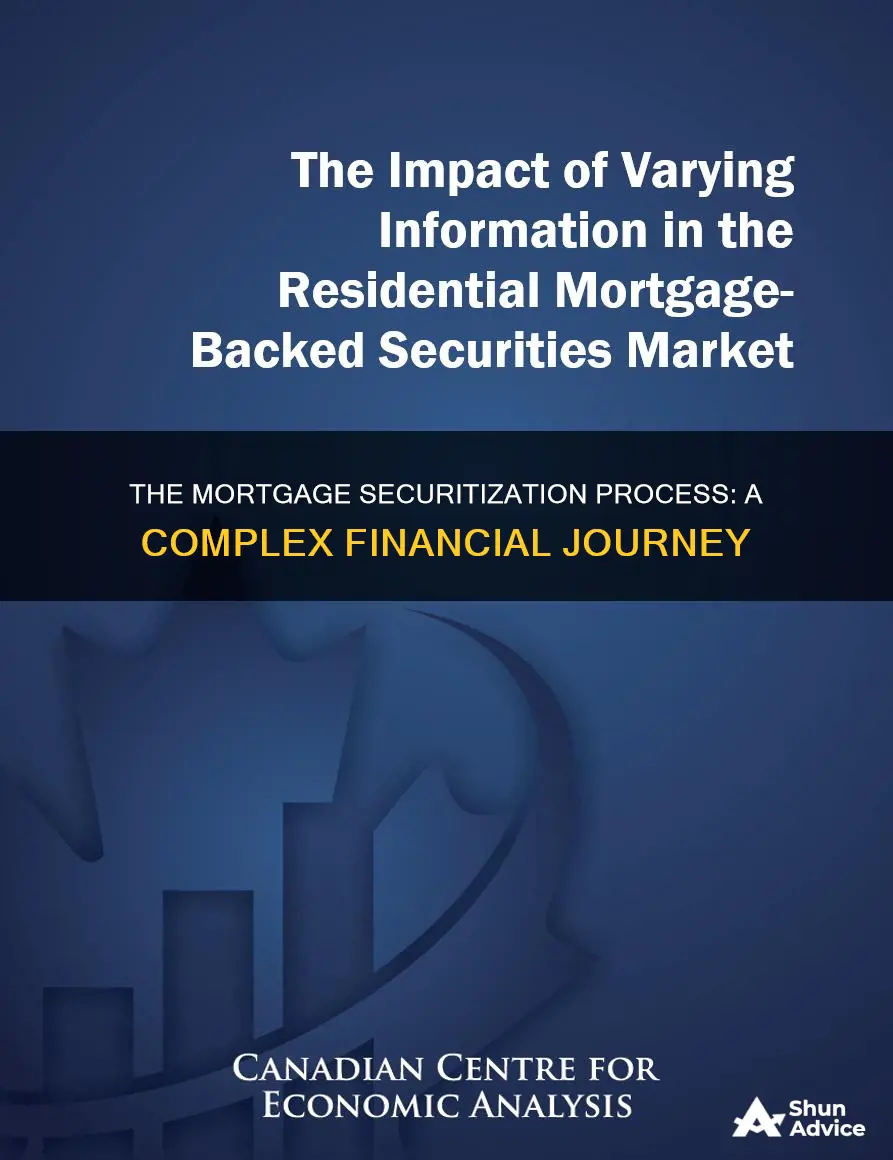
Mortgage securitization is the process of pooling together individual mortgages of similar characteristics and selling them as debt securities that draw interest on principal payments from the pool of mortgages. These are generally referred to as mortgage-backed securities (MBS). The securitization process allows mortgage originators to sell mortgage loans from their books and use the money to make more loans. For homeowners, this means that their mortgage loan does not belong to a single lender but is part of a pool owned by investors. While mortgage securitization can have benefits such as improved liquidity, risk diversification, and more efficient capital allocation, it has also been blamed for the financial crisis of 2007-2008 due to its complex and opaque nature.
| Characteristics | Values |
|---|---|
| Definition | Mortgage securitization is the process of turning illiquid mortgage loans into marketable securities. |
| Process | An authorized institution creates mortgages or home loans, which are then loaned to an individual who borrows money to purchase a real piece of property. All the mortgages or home loans are collected together in a mortgage pool, which are held as collateral for an MBS. A new security is created and is backed by the mortgagor's assets. This new security can be sold, bought, or traded in a secondary mortgage market. |
| Types | Mortgage-backed securities (MBS) and asset-backed securities (ABS) are two types of mortgage securitization. MBS are backed by home loans issued to consumers, while ABS are backed by non-mortgage assets such as auto loans, credit card receivables, student loans, or equipment leases. |
| Pass-through securities | These securities do not have a defined maturity date as principal payments are received with each monthly payment. Examples include collateralized mortgage obligations (CMOs) or real estate mortgage investment conduits. |
| Tranches | The pool of assets is divided into tranches, each with its own risk and return characteristics, maturities, interest rates, and payment priorities. Senior tranches are safer than subordinate tranches and receive payments first. |
| Impact on servicing | Mortgage securitization affects servicing as the entity servicing the loan may change when a loan is securitized. The investor or owner of the loan determines the assistance options available to struggling homeowners. |
| Benefits | Securitization offers improved liquidity, risk diversification, and more efficient capital allocation for lenders and investors. It also allows mortgage originators to sell mortgage loans and use the money to make new loans, recycling loan money back to homeowners. |
| Risks | Securitization can lead to reduced transparency, misaligned incentives, and potential systemic instability. The complexity and lack of transparency of certain structures, such as collateralized debt obligations (CDOs), contributed to the 2007-2008 financial crisis. |
What You'll Learn

The securitization process
The specific steps in the securitization process can vary, but typically an authorized institution creates numerous mortgages or home loans, which are then borrowed by individuals to purchase real estate. These mortgages are collected in a mortgage pool, serving as collateral for an MBS. A new security is then created, backed by the mortgagor's assets, and sold, bought, or traded in a secondary mortgage market.
It is important to note that mortgage securitization has been associated with both positive and negative effects. On the one hand, it has been hailed as a significant financial innovation, providing benefits such as improved liquidity, risk diversification, and more efficient capital allocation. On the other hand, it has also been blamed for contributing to the financial crisis of 2007-2008 due to reduced transparency, misaligned incentives, and systemic instability.
Mortgage Prequalification: Is It Reliable?
You may want to see also

Mortgage-backed securities (MBS)
Securitization turns illiquid assets of individual mortgage loans into marketable securities that can be bought. MBS are created by bundling together many mortgages and selling shares of the resulting pool to investors. This process is known as securitization. The pooled mortgages are sold to a trust, a GSE like Fannie Mae, Freddie Mac, a government agency like Ginnie Mae, or a private financial institution. The trust then structures these loans into MBS. The MBS are issued and sold to investors. MBS issued by government-sponsored enterprises (GSEs) like Fannie Mae and Freddie Mac are examples of pass-through securitization.
MBS investors can buy portions of mortgages and receive regular returns from interest and principal payments. Investors in mortgage-backed securities receive periodic payments like bond coupon payments. MBS typically offer yields that are higher than government bonds. Securities with higher coupons offer the potential for greater returns but carry increased credit and prepayment risk, meaning the realized yield could be lower than initially expected.
The MBS market has evolved significantly since the 2007-2008 financial crisis, which was largely triggered by the collapse of the subprime mortgage market and the complex web of MBS and related derivatives. In the US, the MBS market has more than $11 trillion in outstanding securities and almost $300 billion in average daily trading volume.
Markets: Money, Bonds, Stocks, and Mortgages, What's the Commonality?
You may want to see also

Collateralized debt obligations (CDOs)
CDOs are complex financial instruments that played a significant role in the 2007-2008 global financial crisis, with many of these securities backed by subprime mortgages. The complexity and lack of transparency in these structures made it difficult for investors to understand the true risks involved, leading to a loss of confidence in the securitized product market.
CDOs are often used to manage risk by financial institutions, as they allow for the transfer of risk to investors with different risk appetites. They also enable financial institutions to free up capital by removing debt from their balance sheets, thereby facilitating more lending and investment. Investors can benefit from higher yields by taking on the risk associated with lower-rated tranches, potentially boosting their returns.
CDOs are typically assessed for credit risk based on a probability of default (PD) derived from ratings on the underlying bonds or assets. If some loans default and the cash collected by the CDO is insufficient, those in the lowest, most "junior" tranches will suffer losses first. To attract investors, CDOs may include credit enhancements, such as over-collateralization or insurance, to protect the senior tranches from losses.
The Intricacies of Mortgage Determinations: What You Need to Know
You may want to see also

Foreclosure
The process of securitization can make it challenging to determine the original owner of a loan or mortgage, which is crucial as only the owner of a mortgage can initiate foreclosure. This complexity can be advantageous for those facing foreclosure, as an attorney can defend against it if the original owner is not the one initiating the process.
The impact of securitization on foreclosure decisions is a concern, with evidence suggesting that securitization can lead to tougher foreclosure policies, resulting in higher loan losses. This is because foreclosure reduces the information sensitivity of the optimal security, a risky debt, thus mitigating the adverse selection problem in securitization.
Furthermore, the creation and collapse of mortgage-backed securities during the housing crisis had a significant impact on the foreclosure process. The assignment of securitized loans was often poorly documented, and foreclosures were carried out without a clear interest in the underlying mortgage note. This led to fundamental changes in the foreclosure process, with courts now requiring accurate information on the notice of foreclosure sales.
The process of mortgage securitization has also created opportunities for fraudulent activity, with companies preying on public lists of homes facing foreclosure and attempting to take advantage of people's financial vulnerability. This further complicates the foreclosure process and underscores the importance of seeking reliable legal advice.
Closing Costs: Who Pays What in a Mortgage?
You may want to see also

MBS investors
Mortgage-backed securities (MBS) are a type of investment where mortgages from numerous homeowners are pooled together and sold as marketable securities. MBS investors can buy portions of these mortgage pools and receive regular returns from the interest and principal payments made by the individual homeowners.
The process of securitization allows mortgage originators to sell mortgage loans and use the proceeds to make new loans. This helps to create liquidity in the market by allowing retail investors to buy shares in instruments that would otherwise be unavailable to them. Securitization also helps to reduce the liability on the balance sheet of the originator, allowing them to further underwrite loans.
MBS can be issued by government-sponsored enterprises (GSEs) such as Fannie Mae, Freddie Mac, and Ginnie Mae, or by private financial companies. The GSEs' MBS are known as pass-through securitization, where the securities are structured as debt obligations. The cash flows from the underlying pool of assets are used to pay interest and principal on the securities issued, and they are divided into tranches with different maturities, risk profiles, and payment priorities. Senior tranches are safer than subordinate tranches and are paid first.
Late Mortgage Fees: Collection Methods and Your Options
You may want to see also
Frequently asked questions
Mortgage securitization is the process of turning illiquid mortgage loans into marketable securities. It involves pooling together individual mortgages of similar characteristics and selling debt securities that draw interest on principal payments from the pool of mortgages.
An authorized institution creates numerous mortgages or home loans, which are then claimed by an individual who borrows money to purchase a real piece of property. All of the mortgages or home loans are collected together in a mortgage pool, which are held as collateral for an MBS. A new security is created and is backed by the mortgagor's assets. This new security can be sold, bought, or traded to a secondary mortgage market, such as insurance companies and hedge funds.
Mortgage securitization allows mortgage originators to sell mortgage loans and use the money to make more loans to homeowners. It creates liquidity by allowing retail investors to buy shares in instruments that would be unavailable to them. It also offers improved risk diversification and more efficient capital allocation.
There may be a lack of transparency about the underlying assets, and the potential for misaligned incentives and systemic instability. It can also be challenging to determine the original owner of a loan or mortgage, especially after it has gone through the securitization process, which can impact the foreclosure process.







